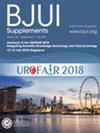Reduced prostate cancer screening has a negative impact on stage migration: the Australian experience
Abstract
Objectives
To determine if Australian prostate cancer screening has declined since the Royal Australasian College of General Practitioners (RACGP) recommended against prostate cancer screening in 2009 and correlate screening trends with more advanced disease at radical prostatectomy (RP) in Australia.
Patients and methods
Histopathology of patients undergoing RP from 2007 to 2018 in the state of New South Wales (NSW), Australia was accessed from a prospectively maintained pathology database by Douglass Hanly Moir, the largest pathology provider in NSW. Prostate-specific antigen (PSA) testing rates were obtained via the Medicare Statistics database (Australian Government). Population data were obtained from the Australian Institute of Health and Welfare and Bureau of Statistics.
Results
Prostate-specific antigen testing decreased significantly in NSW, Australia dropping from 8470 to 4910 tests per 100 000 males from 2009 to 2018, approximately a 5% annual percentage decrease. Histopathology of 17 375 patients who underwent RP during this time showed a 5.4% annual increase in non-organ-confined disease at RP, which was irrespective of Gleason Grade. There was a strong correlation between the decrease in PSA testing with an increase in non-organ-confined disease at RP.
Conclusions
In conclusion, the RACGP guidelines recommending against prostate cancer screening in 2009 correlates strongly with more advanced disease found at RP. This could indicate that patients were presenting later with more advanced disease. However, the increasing use of surveillance of low-grade and favourable intermediate-risk disease and also the potential increasing use of surgery for higher-volume or -grade prostate cancer at diagnosis could impact on the interpretation of our findings. Most international guidelines, as well as the Prostate Cancer Foundation of Australia Guidelines, have now recommended prostate cancer screening in men aged 50–69 years and it is commendable that the latest 2024 RACGP guidelines have been updated to reflect the new evidence supporting prostate cancer screening.


 求助内容:
求助内容: 应助结果提醒方式:
应助结果提醒方式:


